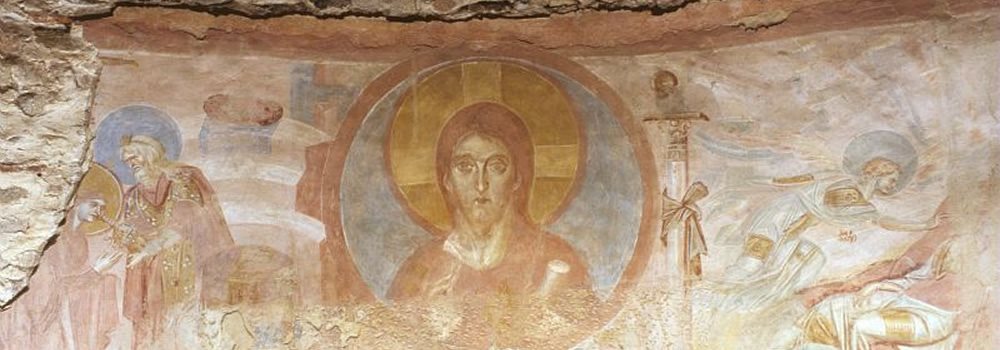The church of Santa Maria "foris portas"
The church of Santa Maria "foris portas" owes a great part of its fame to the exceptional pictorial cycle in the main apse, definitively revealed the 7th of May 1944 by the historian Gian Piero Bognetti.
The extraordinary images in the celebrated scenes, representing the infancy of Christ, taken from the canonical and the apocryphal gospels, are arranged on three superimposed levels:
On the highest level are depicted the Annunciation, the Visitation, of which only a part remains, the Ordeal of the bitter waters, and, above the central window, a large medallion depicting Christ Pantocrator which is followed by the scenes depicting the dream of Joseph and the journey to Bethlehem.
The story continues on the middle level with the episode of the Nativity flanked, on the wall that separates the curved wall of the apse from the nave, by a representation of the Magi adoring Christ. Above the Magi scene the Etimasia is depicted: the empty throne draped with a mantel upon which Christ will sit on the Day of Judgement and on which is placed a crown and a cross. The Estimasia is represented between archangels in flight bearing a sceptre and a globe surmounted by a cross.
In the centre of the apse there is the Presentation of Jesus at the temple, followed by two scenes no longer present.
The third level depicts arcades closed by curtains fixed on poles upon which birds are perched and the representation of a stool covered by a drape upon which rests a book.
The exceptional discovery of this fresco cycle, beneath the layer of whitewash that had been used to cover it, has opened a still lively debate regarding the chronology, the commissioner, the origin of the artist and the interpretation of the scenes.
The extraordinary images in the celebrated scenes, representing the infancy of Christ, taken from the canonical and the apocryphal gospels, are arranged on three superimposed levels:
On the highest level are depicted the Annunciation, the Visitation, of which only a part remains, the Ordeal of the bitter waters, and, above the central window, a large medallion depicting Christ Pantocrator which is followed by the scenes depicting the dream of Joseph and the journey to Bethlehem.
The story continues on the middle level with the episode of the Nativity flanked, on the wall that separates the curved wall of the apse from the nave, by a representation of the Magi adoring Christ. Above the Magi scene the Etimasia is depicted: the empty throne draped with a mantel upon which Christ will sit on the Day of Judgement and on which is placed a crown and a cross. The Estimasia is represented between archangels in flight bearing a sceptre and a globe surmounted by a cross.
In the centre of the apse there is the Presentation of Jesus at the temple, followed by two scenes no longer present.
The third level depicts arcades closed by curtains fixed on poles upon which birds are perched and the representation of a stool covered by a drape upon which rests a book.
The exceptional discovery of this fresco cycle, beneath the layer of whitewash that had been used to cover it, has opened a still lively debate regarding the chronology, the commissioner, the origin of the artist and the interpretation of the scenes.



